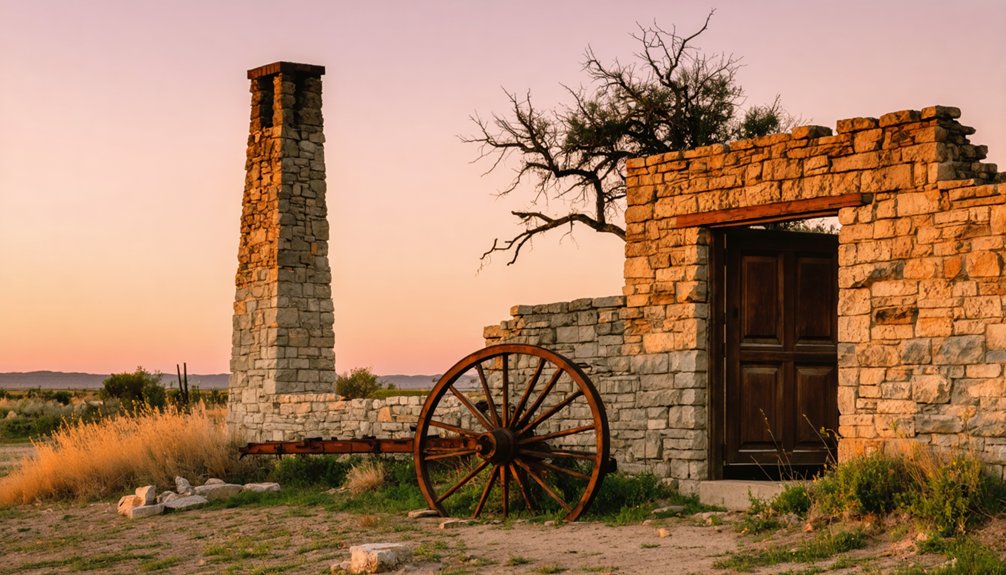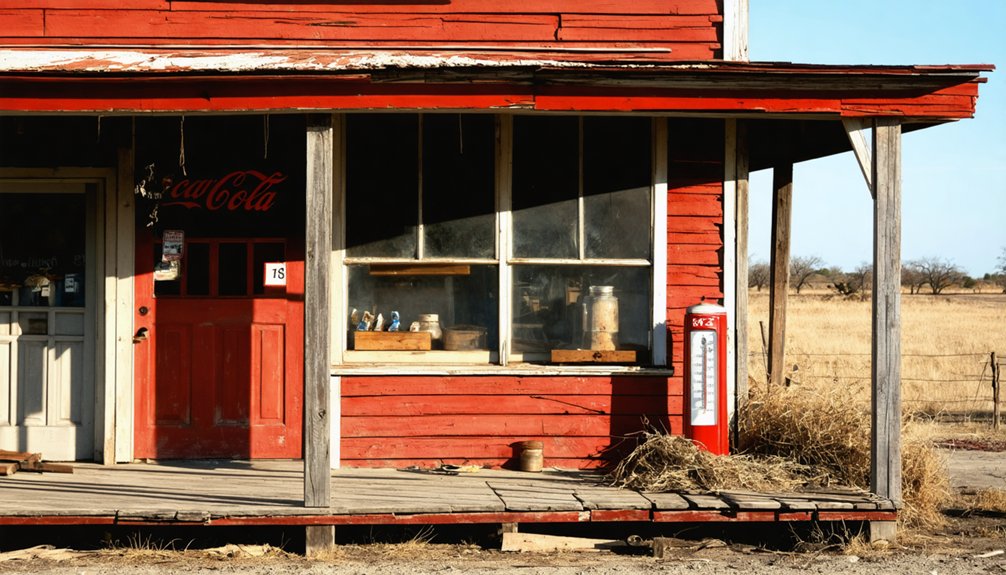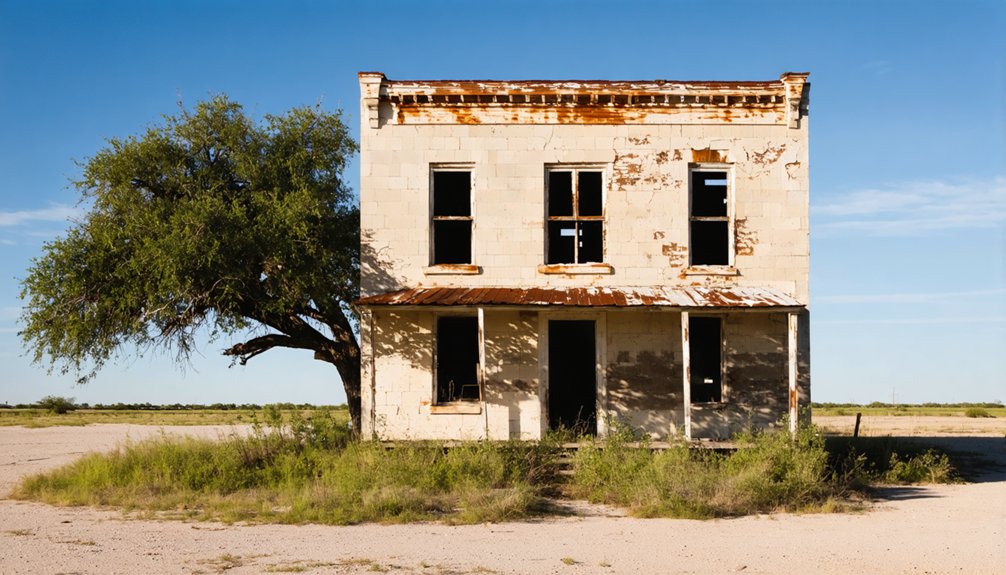You’ll find the ghost town of Vandenburg, Texas along Verde Creek, where Henri Castro established a frontier settlement in 1846. Despite initial success with agriculture and community development, the town faced severe water challenges that led to its downfall. Early settlers dug wells up to 135 feet deep, but persistent droughts and unreliable water sources forced residents to abandon the settlement. The story of Vandenburg reveals fascinating insights about frontier life and environmental adaptation in 19th-century Texas.
Key Takeaways
- Vandenburg was established in 1846 by Henri Castro along Verde Creek as a Texas frontier colony.
- Severe water shortages and failed well-digging attempts forced settlers to rely on distant water sources.
- The town experienced devastating droughts from 1847-1849, leading to cholera outbreaks and agricultural decline.
- Despite initial agricultural success, water scarcity ultimately forced residents to abandon the settlement.
- The ghost town’s physical remnants have largely disappeared, leaving only historical records of its frontier settlement story.
Origins and Pioneer Settlement Days
When Henri Castro established Vandenburg in 1846 along Verde Creek, the settlement marked an important addition to Texas’s expanding frontier colonies.
In 1846, Henri Castro’s Vandenburg settlement along Verde Creek became a vital outpost in Texas’s growing frontier expansion.
You’ll find this pioneering community situated at 29° 23′ 27.816″ N, 99° 8′ 1.572″ W, where early settlers demonstrated remarkable pioneer resilience as they built homes and cultivated substantial tracts of land near the creek.
These determined colonists focused on agricultural innovations, bringing considerable acreage under cultivation in their quest to create a self-sustaining community.
Their efforts to tame the frontier reflected the broader movement of settlement across Texas during the mid-19th century, much like William Mingus who settled in 1856 and helped establish another Texas frontier town.
While infrastructure remained basic, with no early churches or schools, the settlers’ commitment to farming and land development showcased their determination to carve out a new life in the Texas wilderness. The community faced significant challenges when they had to dig a well 135 feet deep to find water for their farms.
The Quest for Water and Early Challenges
You’ll find that Vandenburg’s early settlers faced severe water challenges, initially relying on Verde Creek until its seasonal drying forced desperate searches for alternative sources.
Interestingly, the settlement’s name referenced its elevated position, much like the Dutch surname meaning from the mountain.
In 1857, the community undertook an ambitious well-digging project, reaching 135 feet deep before water gradually accumulated to 15 feet below ground level. While this well provided limited support for local farming, the settlement’s primary dependence on unreliable surface water ultimately led most inhabitants to abandon their homes and establish New Fountain near a more dependable spring in 1846. This situation mirrors the challenges faced by communities along the Sabine River, where the creation of Toledo Bend Reservoir permanently altered access to traditional water sources.
Early Well Digging Efforts
The early settlers of Vandenburg faced a critical water crisis as they initially depended on Verde Creek‘s unreliable flow for their survival and farming needs.
When the creek repeatedly dried up during summer months, they turned to well technology as their last hope for independence from surface water sources.
In a demonstration of their determination, settlers dug an impressive 135-foot well using primitive water sourcing methods.
Though they initially abandoned the effort after finding no water, they soon discovered the well slowly filling from underground aquifers.
The water eventually rose to within fifteen feet of the surface, providing a lifeline for the few remaining farmers.
Many settlers relocated downstream to establish New Fountain, where a promising water source had been discovered.
While this discovery came too late to prevent many settlers from relocating to New Fountain, it proved that persistent exploration could overcome the region’s harsh conditions.
This water-finding challenge was reminiscent of early Plemons Crossing settlers, who relied on a special horse to detect dangerous quicksand near water sources.
Creek Dependence and Shortages
Life in early Vandenburg revolved around its precious creek water supplies, which proved devastatingly unreliable for the settlement’s growing needs.
You’ll find that settlers depended heavily on surface water from sources like Seco Creek for both household use and farming, with minimal creek conservation efforts in place.
The region’s water management challenges came to a head during the severe drought of 1847-1849, when creek flows dwindled to critical levels.
Poor water quality, combined with inadequate sanitation, led to cholera outbreaks. The karst geology and seasonal variations made creek water increasingly unreliable, while seepage from the Nueces and Medina rivers couldn’t sufficiently replenish local aquifers. The area’s limestone-rich terrain, typical of the Balcones Escarpment, further complicated water retention efforts.
Major William S. Henry documented how residents had to haul water from three miles away due to the stream’s insufficient flow.
Desperate Water Search Methods
Desperately searching for reliable water sources, early Vandenburg settlers employed multiple primitive methods to sustain their growing community.
You’d find them digging shallow wells into limestone bedrock, though these often ran dry or became contaminated. Community cooperation emerged as settlers formed water-hauling groups, making long treks to rivers and springs with horses and wagons.
Water conservation became essential as they developed rainwater harvesting systems, building stone cisterns to capture precious roof runoff. The area’s location near the Vandenburg School fault created additional challenges for accessing consistent groundwater supplies.
They’d experiment with hand pumps and windmills when possible, though mechanical failures were common. To combat poor water quality, they’d boil surface water and let sediments settle.
During severe shortages, they’d reuse grey water for non-drinking purposes while searching for cleaner spring sources farther from their settlement.
From Thriving Community to Abandonment
Despite early success with farming and an established creek water source, Vandenburg’s settlers faced increasingly severe droughts that ultimately devastated their water supply.
You’ll find that by the late 1800s, the combination of failed well-digging attempts and a dried-up creek left residents with no choice but to abandon their homes.
Most families relocated to New Fountain, Texas, where better resources promised a more sustainable future, leaving Vandenburg to join the growing list of Texas Hill Country ghost towns. Similar to Vandenburg’s fate, towns like Thurber saw their populations dwindle when the transition to oil caused widespread mine closures.
Water Scarcity Forces Exodus
While Vandenburg initially thrived as a settlement centered around its creek-fed water supply, the community’s dependence on this single water source ultimately led to its downfall.
When the creek dried up during summer months, you’d have witnessed the community’s desperate attempts at resource management through well-digging efforts that reached 135 feet deep.
Despite this show of community resilience, the well yielded minimal water, barely supporting a handful of remaining farms.
Settlement’s Brief Farming Period
During its brief agricultural heyday in the mid-1800s, Vandenburg emerged as a promising farming settlement near Verde and Lucky Creek, where settlers quickly established homes and cultivated substantial farmland.
You’d have found pioneering farming techniques that relied heavily on creek-fed irrigation systems to sustain diverse crops, while the fertile land initially rewarded these agricultural efforts.
The settlement’s early success allowed for modest growth and basic infrastructure development, but you’ll notice how nature ultimately challenged their persistence.
Despite attempts to diversify crop production and implement new farming techniques, including digging deep wells reaching 135 feet, the community couldn’t overcome its water limitations.
Life in Old Vandenburg

As settlers established their lives in Vandenburg during the early years, this small Texas farming community revolved around agricultural pursuits and daily survival.
You’d find hardworking families tending to their crops and livestock, battling against nature’s unpredictable rhythms. Community resilience showed through shared efforts like well-digging projects, reaching depths of 135 feet in search of precious water.
Agricultural practices centered on subsistence farming, but the harsh reality of water scarcity challenged even the most determined settlers.
The town’s modest infrastructure reflected its rural character, with scattered farmhouses and agricultural buildings dotting the landscape. Life wasn’t easy – you’d have to manage your water carefully during the dry summers when the creek levels dropped, often forcing difficult decisions about crop cultivation and livestock maintenance.
Environmental Forces and Town’s Fate
The harsh realities of water scarcity ultimately sealed Vandenburg’s fate. When Verde Creek dried up in the mid-19th century, you’d have witnessed the town’s environmental sustainability crumble as settlers struggled to find reliable water sources.
When Verde Creek ran dry, Vandenburg’s hopes evaporated with it, leaving settlers desperately searching for water in an unforgiving landscape.
A desperate 135-foot well project failed to yield sufficient water, forcing many residents to relocate downstream to New Fountain.
The town’s agricultural resilience faced devastating blows in the 1880s when severe droughts struck. You’d have seen crops fail as soil degradation intensified, making farming virtually impossible.
The environmental challenges didn’t stop there – the lack of clean water led to cholera outbreaks and other health hazards. Without the means to overcome these natural barriers, Vandenburg’s remaining residents were forced to abandon their homes, leaving the settlement to become the ghost town it remains today.
Legacy and Historical Significance

While Vandenburg’s physical remnants have largely vanished, its legacy endures as a monument to mid-19th century frontier settlement patterns in Texas Hill Country.
You’ll find in its story valuable lessons about economic resilience, as the town’s dependence on agriculture and limited water resources ultimately led to its downfall.
The settlement’s evolution from a hopeful farming community to an abandoned ghost town mirrors the historical migration patterns that shaped early Texas development.
Today, though its structures lie on private land, Vandenburg serves as a compelling case study for researchers and historians, illustrating how environmental challenges could make or break frontier communities.
Its transformation into farmland symbolizes the adaptability required for survival in Texas’s pioneering era.
Frequently Asked Questions
Are There Any Paranormal Activities Reported in the Abandoned Town Site?
You won’t find documented ghost sightings or haunted locations here. Unlike Texas’s more notorious paranormal hotspots, there’s no verified evidence of supernatural activity at this remote, forgotten destination.
What Native American Tribes Originally Inhabited the Vandenburg Area?
You’ll find the Comanche dominated this area’s tribal history, while Apache and Tonkawa tribes also held cultural significance here. Earlier indigenous groups included the Jumano, Coahuiltecan, and Kiowa peoples.
How Did the Town’s Name Originate?
Like uncovering treasure in old records, you’ll find the town history points to early settlers named Vandenberg (or Vandenburg), whose family name became the settlement’s identity during mid-1800s westward expansion.
Were There Any Notable Crimes or Conflicts in Vandenburg?
You won’t find evidence of significant crime history or conflict resolution in historical records. The town’s brief existence and early departure due to water issues left little time for notable disturbances.
What Happened to the Cemetery and Graves of Original Settlers?
You’ll find most original settlers’ graves have deteriorated, with damaged headstones and iron fencing marking their final resting places. No major grave relocation or cemetery preservation efforts have protected these historic burial sites.
References
- https://www.historictexas.net/city/vandenburg-texas
- https://www.youtube.com/watch?v=EcKNorOzxtk
- https://www.youtube.com/watch?v=phjUE19A8HM
- https://www.southernthing.com/ruins-in-texas-2640914879.html
- https://en.wikipedia.org/wiki/List_of_ghost_towns_in_Texas
- https://www.ghosttowns.com/states/tx/vandenberg.html
- https://www.hmdb.org/m.asp?m=79257
- https://www.tshaonline.org/handbook/entries/vandenburg-tx
- https://www.youtube.com/watch?v=PsuLwAQ12QI
- http://texappealmag.com/texas-ghost-towns-explore-haunting-remnants-of-forgotten-cities/



